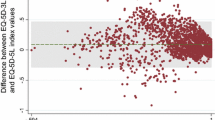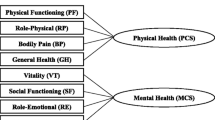Abstract
Purpose
To evaluate the reliability and validity of the EQ-5D in a general population sample in urban China.
Methods
Thousand and eight hundred respondents in 18 communities of Hangzhou, China were recruited by multi-stage stratified random sampling. Respondents self-administered a questionnaire including the EQ-5D, the SF-36, and demographic questions. Test–retest reliability at 2-week intervals was evaluated using Kappa coefficient, the intraclass correlation coefficient. The standard error of measurement (SEM) was used to indicate the absolute measurement error. Construct validity was established using convergent, discriminant, and known groups analyses.
Results
Complete data for all EQ-5D dimensions were available for 1,747 respondents (97%). Kappa values were from 0.35 to 1.0. The ICCs of test–retest reliability were 0.53 for the EQ-5D index score and 0.87 for the EQ VAS score. The SEM values were 0.13 (9.22% range) and 4.20 (4.20% range) for the EQ-5D index and EQ VAS scores, respectively. The Pearson’s correlation coefficients between the EQ-5D and the SF-36 were stronger between comparable dimensions than those between less comparable dimensions, demonstrating convergent and discriminant evidence of construct validity. The Chinese EQ-5D distinguished well between known groups: respondents who reported poor general health and chronic diseases had worse HRQoL than those without. Older people, females, people widowed or divorced, and those with a lower socioeconomic status reported poorer HRQoL. Respondents reporting no problems on any EQ-5D dimension had better scores on the SF-36 summary scores than those reporting problems.
Conclusions
The Chinese version of the EQ-5D demonstrated acceptable construct validity and fair to moderate levels of test–retest reliability in an urban general population in China.
Similar content being viewed by others
Abbreviations
- HRQoL:
-
Health-related quality of life
- VAS:
-
Visual analogue scale
References
Rabin, R., & de Charro, F. (2001). EQ-5D: A measure of health status from the EuroQol Group. Annals of Medicine, 33(5), 337–343.
Wang, H., Kindig, D. A., & Mullahy, J. (2005). Variation in Chinese population health related quality of life: results from a EuroQol study in Beijing, China. Quality of Life Research, 14(1), 119–132.
Sun, S., Chen, J., Johannesson, M., Kind, P., Xu, L., Zhang, Y., et al. (2011). Population health status in China: EQ-5D results, by age, sex and socio-economic status, from the national health services survey 2008. Quality of Life Research, 20(3), 309–320.
Zhao, F. L., Yue, M., Yang, H., Wang, T., Wu, J. H., & Li, S. C. (2010). Validation and comparison of EuroQol and short form 6D in chronic prostatitis patients. Value Health, 13(5), 649–656.
Lubetkin, E. I., Jia, H., & Gold, M. R. (2004). Construct validity of the EQ-5D in low-income Chinese American primary care patients. Quality of Life Research, 13(8), 1459–1468.
Leung, B., Luo, N., So, L., & Quan, H. (2007). Comparing three measures of health status (perceived health with Likert-type scale, EQ-5D, and number of chronic conditions) in Chinese and white Canadians. Medical Care, 45(7), 610–617.
Luo, N., Chew, L. H., Fong, K. Y., Koh, D. R., Ng, S. C., Yoon, K. H., et al. (2003). Validity and reliability of the EQ-5D self-report questionnaire in Chinese-speaking patients with rheumatic diseases in Singapore. Ann Acad Med Singap, 32(5), 685–690.
Brooks, R. (1996). EuroQol: The current state of play. Health Policy, 37(1), 53–72.
Dolan, P. (1997). Modeling valuations for EuroQol health states. Medical Care, 35(11), 1095–1108.
Ware, J. E., Snow, K. K., Kosinski, M., & Gandek, B. (1993). SF-36 Health survey manual and interpretation guide. Boston, MA: The Health Institute, New England Medical Center.
Li, L., Wang, H. M., & Shen, Y. (2003). Chinese SF-36 health Survey: Translation, cultural adaptation, validation, and normalisation. Journal of Epidemiology and Community Health, 57(4), 259–263.
Scientific Advisory Committee of the Medical Outcomes Trust. (2002). Assessing health status and quality-of-life instruments: attributes and review criteria. Quality of Life Research, 11(3), 193–205.
Landis, J. R., & Koch, G. G. (1977). The measurement of observer agreement for categorical data. Biometrics, 33(1), 159–174.
Shrout, P. E., & Fleiss, J. L. (1979). Intraclass correlations: uses in assessing rater reliability. Psychological Bulletin, 86(2), 420–428.
Staquet, M. J., Hays, R. D., & Fayers, P. M. (1998). Quality of life assessment in clinical trials: Methods and practice (pp. 169–182). Oxford: Oxford University Press.
Terwee, C. B., Bot, S. D., de Boer, M. R., van der Windt, D. A., Knol, D. L., Dekker, J., et al. (2007). Quality criteria were proposed for measurement properties of health status questionnaires. Journal of Clinical Epidemiology, 60(1), 34–42.
de Vet, H. C., Terwee, C. B., Knol, D. L., & Bouter, L. M. (2006). When to use agreement versus reliability measures. Journal of Clinical Epidemiology, 59(10), 1033–1039.
Cohen, J. (1992). A power primer. Psychological Bulletin, 112(1), 155–159.
Tsuchiya, A., Ikeda, S., Ikegami, N., Nishimura, S., Sakai, I., Fukuda, T., et al. (2002). Estimating an EQ-5D population value set: the case of Japan. Health Economics, 11(4), 341–353.
Johnson, J. A., & Coons, S. J. (1998). Comparison of the EQ-5D and SF-12 in an adult US sample. Quality of Life Research, 7(2), 155–166.
Kind, P., Dolan, P., Gudex, C., & Williams, A. (1998). Variations in population health status: results from a United Kingdom national questionnaire survey. BMJ, 316(7133), 736–741.
Kontodimopoulos, N., Pappa, E., Niakas, D., Yfantopoulos, J., Dimitrakaki, C., & Tountas, Y. (2008). Validity of the EuroQoL (EQ-5D) instrument in a Greek general population. Value Health, 11(7), 1162–1169.
Brazier, J., Jones, N., & Kind, P. (1993). Testing the validity of the Euroqol and comparing it with the SF-36 health survey questionnaire. Quality of Life Research, 2(3), 169–180.
Hangzhou Bureau of Statistics. (2008). Hangzhou statistical yearbook. http://www.hzstats.gov.cn/web/. Accessed 15th September 2010.
Fryback, D. G., Dunham, N. C., Palta, M., Hanmer, J., Buechner, J., Cherepanov, D., et al. (2007). US norms for six generic health-related quality-of-life indexes from the National Health Measurement study. Medical Care, 45(12), 1162–1170.
König, H. H., Bernert, S., Angermeyer, M. C., Matschinger, H., Martinez, M., Vilagut, G., et al. (2009). Comparison of population health status in six european countries: Results of a representative survey using the EQ-5D questionnaire. Medical Care, 47(2), 255–261.
Kottner, J. (2009). Interrater reliability and the kappa statistic: a comment on Morris et al. (2008). International Journal of Nursing Studies, 46(1), 140–141.
Bartko, J. J. (1991). Measurement and reliability: statistical thinking considerations. Schizophrenia Bulletin, 17(3), 483–489.
Terwee, C. B., Roorda, L. D., Knol, D. L., De Boer, M. R., & De Vet, H. C. (2009). Linking measurement error to minimal important change of patient-reported outcomes. Journal of Clinical Epidemiology, 62(10), 1062–1067.
de Boer, M. R., de Vet, H. C., Terwee, C. B., Moll, A. C., Völker-Dieben, H. J., & van Rens, G. H. (2005). Changes to the subscales of two vision-related quality of life questionnaires are proposed. Journal of Clinical Epidemiology, 58(12), 1260–1268.
Mannion, A. F., Boneschi, M., Teli, M., Luca, A., Zaina, F., Negrini, S., et al. (2011). Reliability and validity of the cross-culturally adapted Italian version of the core outcome measures index. Eur Spine J. [Epub ahead of print].
Chang, T. J., Tarn, Y. H., Hsieh, C. L., Liou, W. S., Shaw, J. W., & Chiou, X. G. (2007). Taiwanese version of the EQ-5D: validation in a representative sample of the Taiwanese population. Journal of the Formosan Medical Association, 106(12), 1023–1031.
Sjöström, O., & Holst, D. (2002). Validity of a questionnaire survey: response patterns in different subgroups and the effect of social desirability. Acta Odontologica Scandinavica, 60(3), 136–140.
Acknowledgments
This work was supported by a grant of the National Natural Science Foundation of China (No.70603024). We gratefully acknowledge all investigators involved in the collection and management of data.
Conflict of interest
The authors declare no conflict of interests.
Author information
Authors and Affiliations
Corresponding author
Rights and permissions
About this article
Cite this article
Wang, HM., Patrick, D.L., Edwards, T.C. et al. Validation of the EQ-5D in a general population sample in urban China. Qual Life Res 21, 155–160 (2012). https://doi.org/10.1007/s11136-011-9915-6
Accepted:
Published:
Issue Date:
DOI: https://doi.org/10.1007/s11136-011-9915-6




